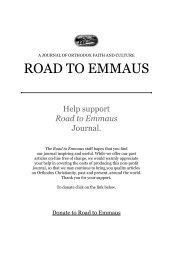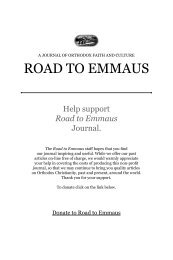RTE No 20 Interior - Road to Emmaus Journal
RTE No 20 Interior - Road to Emmaus Journal
RTE No 20 Interior - Road to Emmaus Journal
You also want an ePaper? Increase the reach of your titles
YUMPU automatically turns print PDFs into web optimized ePapers that Google loves.
<strong>Road</strong> <strong>to</strong> <strong>Emmaus</strong> Vol. XIII, <strong>No</strong>. 2 (#49)Natural Conception, Natural BirthRtE: Before discussing the ethical and spiritual aspects of fertility treatments,perhaps we can begin by describing these widely-used medical technologies.Many Orthodox Christians share our western society’s generalbelief that both fertility and birth control drugs and procedures are relativelybenign, or at least safer than they were decades ago, and see no reason <strong>to</strong>deviate from the regular medical route. Is it true that there has been a rise ininfertility in America and Europe, and why might we want <strong>to</strong> consider usingmore natural means <strong>to</strong> conceive?Melanie: Infertility has become an epidemic, particularly unexplained infertility.Statistics range from 10-13% of women age 15-44 who have beenunable <strong>to</strong> conceive or <strong>to</strong> carry a child <strong>to</strong> term after a year of unprotected intercourse.Two very obvious reasons are that women are now delaying marriageand childbirth. Fertility takes a distinct plunge at age 35—but mostwomen aren’t given even this simple information, certainly not in school.We think that we have many years <strong>to</strong> have a child, because we see womenwho are forty and pregnant, but we don’t realize that this may be the resul<strong>to</strong>f extensive fertility treatments. This is the easy first piece of the puzzle, thatwe are delaying marriage and childbirth.There can also be infertility problems with the husband. Roughly, 30%of infertility problems can be traced <strong>to</strong> the mother, 30% <strong>to</strong> the father, andthe remaining 40% <strong>to</strong> a combination of problems with both spouses orunknown causes.<strong>No</strong> one can quite put their finger on the unexplained aspects and there is alot of conjecture about whether it could be nutrition, particularly the estrogenand antibiotics that we are pumping in<strong>to</strong> animals. Is it possible that the foodwe are ingesting is making us so sick that we can’t reproduce? Another obviousplace <strong>to</strong> look is at the continued use of hormonal birth control pills andthe long-term effects they have on a woman and her reproductive system.The New Birth ControlRtE: Hasn’t the birth control pill changed quite a lot since it first came on themarket in the 1960’s?Melanie: Yes. In the beginning, it only inhibited ovulation and the activeingredient was progestin, a synthetic version of the natural progesterone inthe body. Since then, they’ve added estrogen <strong>to</strong> s<strong>to</strong>p break-through bleeding,so now you have these two primary female sex hormones coursing throughthe blood system, although in a different way than the body uses them.Also, now we have the mini-pill, a combination of hormones that inhibi<strong>to</strong>vulation. Should the woman ovulate anyway, a secondary mechanism ofthe pill thickens the cervical mucus so that the sperm will never reach theegg for fertilization. If both mechanisms should fail and the sperm meets theegg, there is a third obstacle in that the lining of the uterus has been madeso thin that the fertilized zygote—the earliest developmental phase of theembryo—cannot implant. This is why many people consider the pill <strong>to</strong> bean abortifacient, because it causes the expulsion of the fertilized egg. Thisis what the “morning-after” pill did. Initially, the pill didn’t function in thesame way.Some doc<strong>to</strong>rs will probably say, “Oh, that will never happen, the suppressionof ovulation and the thickening of the cervical mucus will prevent pregnancy,but I would ask, “Why wouldn’t you err on the side of caution? If youknow that this can be a mechanism of the pill, even if it happens rarely, whywould you want <strong>to</strong> consent?Even more fundamentally, the pill gives an impression of normalcy. This isvery illusory, because it appears that you still have your “menstrual period”each month, but this is not true menstruation because you haven’t ovulated.The placebo hormones you are taking simply cause the artificially scant uterinelining <strong>to</strong> shed. Although it gives an impression that you are having aperiod and that things are normal and going along the way they always have,that’s not true.When the birth control pill Seasonique came out, enabling women <strong>to</strong> only“menstruate” four times a year, there were mixed reviews. Some womensaid, “Great, I hardly ever have <strong>to</strong> have my period again,” but the truth isthat they were never having their period <strong>to</strong> begin with if they were on the pill.Other people said, “<strong>No</strong>, that’s just so freaky, you can’t mess with nature likethat,” but likewise, they didn’t realize that these women hadn’t been menstruatingat all.RtE: What are the other health risks of these new pills?Melanie: We always knew that thrombosis was one of the possible side effects,but now with the lower dosage pills such as Yaz, the risk of blood clotsis about 50% greater than with regular birth control pills, and they aren’tsure why. There is now a class action lawsuit against this particular pill. Also,45










